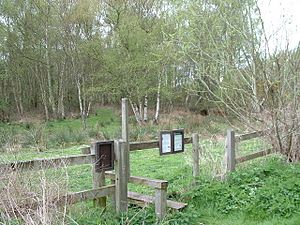Roydon Common facts for kids
| Site of Special Scientific Interest | |
 |
|
| Area of Search | Norfolk |
|---|---|
| Interest | Biological |
| Area | 194.9 hectares (482 acres) |
| Notification | 1984 |
| Location map | Magic Map |
Roydon Common is a special natural area in Norfolk, England. It covers about 195 hectares, which is like 480 football fields! This place is important for its amazing wildlife and plants. It's known as a Site of Special Scientific Interest (SSSI) because of its unique nature.
Roydon Common is also a National Nature Reserve. This means it's one of the best places in the country for nature. It's also a Ramsar site, which is an international award for important wetlands. Plus, it's part of a larger Special Area of Conservation. The Norfolk Wildlife Trust helps look after this amazing place.
|
Designations
|
|
| Official name: Roydon Common | |
| Designated: | 5 March 1993 |
|---|---|
| Reference #: | 588 |
Contents
What Makes Roydon Common Special?
Roydon Common is famous for its "lowland mixed valley mire." This is a type of wetland with different wet and dry areas. It has wet, acidic heathland and also dry, sandy heathland. This mix of habitats makes it a home for many rare plants, birds, and insects.
Plants You Might See
Many special plants grow here. You might find black bogrush and marsh fern. There are also plants like cranberry and bog asphodel. Common cotton-grass adds a fluffy touch to the landscape. Look closely for all three types of sundew, which are cool insect-eating plants! You can also spot different kinds of sphagnum moss.
Insects and Butterflies
Roydon Common is a great place for insects. Rare dragonflies, like the black darter and the broad-bodied chaser, live here. In the drier, grassy spots, many flowers grow. These flowers attract beautiful butterflies. Keep an eye out for green and purple hairstreaks, and the brown argus butterfly.
Visiting Roydon Common
You can explore Roydon Common using its footpaths. One path starts from a village called Pott Row. This path runs along the southern edge of the common. It's a great way to see the different habitats and wildlife.

